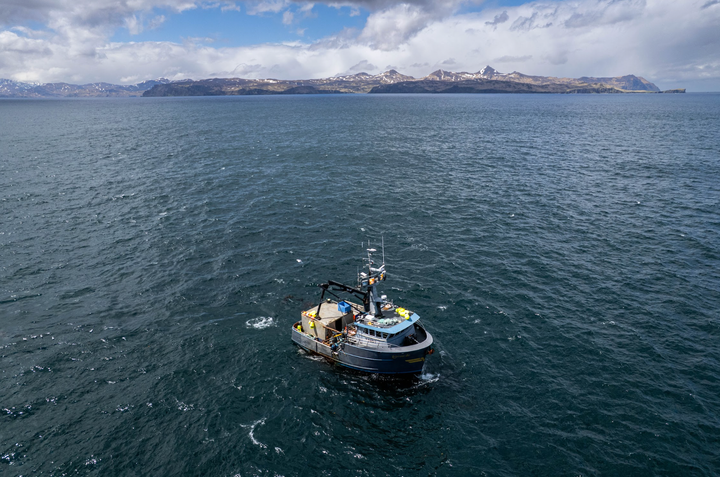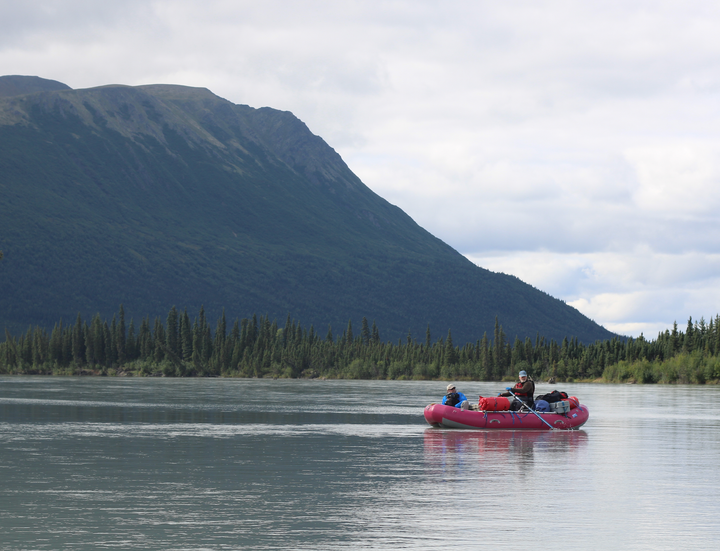An unexpected friendship flight: How two Chinese pilots landed in a tiny Iñupiaq village in Alaska
After a blizzard forced an emergency landing in the Bering Strait village of Teller, the pilots have been sampling local delicacies.

Editor’s note: Northern Journal typically sticks to stories that won’t be reported elsewhere, since we’re a staff of two. But correspondent Max Graham and I have both spent recent weeks working on in-depth stories, and sometimes we, and readers, need something that’s a little more fun. Hence, when some strange news popped up on social media this morning, Max and I had the following text exchange:

While Northern Journal will remain a space for sober coverage of the state’s environment and natural resources, today it’s also a space for this nice little vignette from rural Alaska. Enjoy.
Unexpected guests joined students for school lunch Thursday in the small Western Alaska village of Teller: Two Chinese pilots, speaking broken English, who had made an emergency landing the night before on the village’s gravel airstrip during a blizzard — after flying across the Bering Strait from Russia.
Ping Wang, 37, and Shenghao Luo, 41, left the city of Anadyr, in Russia’s Far East, Wednesday in a Chinese aircraft called a Harbin Y-12 — a twin-engine propeller plane that’s similar to a de Havilland Otter, a staple of Alaska Bush flying.
En route to Anchorage — on a much longer journey to deliver the plane to potential buyers in Chile — they planned to stop in Nome to refuel. But amid a storm, “the aircraft’s wings began to ice up, and the runway remained invisible,” and the pilots were forced to divert, they said in an email to Northern Journal.

Coordinating with air traffic controllers in Anchorage, the pilots landed some 60 miles north in Teller.
The Iñupiaq village, population 235, could hardly be more foreign to Wang and Luo, who respectively hail from the Chinese cities of Shanghai, population 25 million, and Zhuhai, population 2.5 million.
They’re now being put up at the village’s school, where residents, undeterred by America's geopolitical tensions with China, have given the visitors red carpet treatment — including locally harvested subsistence foods.
“Teller is a beautiful place, and its people are simple, sincere, and extremely hospitable—many children at the school were curious about us and took the initiative to communicate, which warmed our hearts deeply,” the pilots said in their email.
Data on Alaska landings of Chinese aircraft could not immediately be located Thursday. But residents say it’s extremely rare for one to show up in Teller — or elsewhere in rural Alaska, for that matter.
The surprise landing, first reported on social media and in other news outlets, has fueled all kinds of speculation. That includes one Facebook commenter’s suggestion that the Y-12 intentionally flew near a proposed graphite mine that a Canadian company, with funding from the Pentagon, hopes to build to help break China’s near monopoly on the mineral, which is used in electric vehicle batteries.
Another commenter joked that the visitors had flown in on a “Temu Twin Otter,” referring to the Chinese ecommerce site and the de Havilland plane.
“We all are wondering: How in the world did someone from a different country land here?” one Teller resident, who declined to be identified, said by phone.
But the ordeal, which has highlighted the trademark hospitality of Alaska’s rural communities, also has echoes — albeit muted ones — of the 1988 “Friendship Flight” across the Bering Strait, which aimed to thaw Cold War tensions between Russians and Alaskans.

The Teller community has offered “tremendous help,” the pilots said. Residents helped secure the plane in a blizzard, arranged for them to stay at the school and prepared meals for them.
Around 6 p.m. Wednesday, Jimmy Pushruk, the village’s airport manager, heard that the plane was circling around Teller — a surprise to him, given that the bad weather had forced the cancelation of the village’s regular commercial air service from Nome.
“I went out to meet the airplane in blizzardy conditions,” Pushruk said by phone Thursday. “It was kind of unusual.”
The Y-12 was low on fuel and had “considerable” ice buildup on its wings and fuselage, he said.
The pilots might be stuck in Teller for a while, Pushruk added. “They need fuel, they need deicing, they need a mechanic to fly from Anchorage to Teller.”
Through an employee of the Teller school, Northern Journal sent questions translated into Mandarin to the pilots, who responded in English with several detailed paragraphs and a number of photos.

The two pilots started in the city of Harbin, in northern China, and passed through several cities in Russia — Blagoveshchensk, Yakutsk, Magadan and Anadyr — before crossing to the United States, they said.
Their final destination is Chile, where they intend to deliver the plane to an exhibition on behalf of its manufacturer.
A spokesperson for the Alaska State Troopers said the agency is “aware” of an international flight that diverted from Nome to Teller.
“It’s not uncommon for flights in Western Alaska to be diverted to nearby airports due to weather,” the spokesperson, Austin McDaniel, said in a text message. International travel in the region is not uncommon, he added, noting that Nome is a port of entry for U.S. Customs and Border Protection.
Still, Teller residents told Northern Journal they don’t remember an international flight arriving in the village without warning before.
Within the pilots’ first 24 hours on Alaska soil, they had already sampled reindeer and ate baked salmon for lunch at the Teller school — ”very delicious food,” they said by email. In the plane, they added, were “only drinks and some snacks like Snickers.”
“We are profoundly grateful,” they added, describing how Alaska air traffic controllers and Teller residents “saved” them.
“If we ever have the chance to travel to Alaska again, we will definitely choose Teller,” they said. “And we will bring our families here to express our sincere thanks in person!”
Jonas Crimm contributed research.
If you like reporting like this, Northern Journal can't survive without paid memberships from readers, so please consider subscribing by clicking the button above. If you're already a subscriber, thank you.



